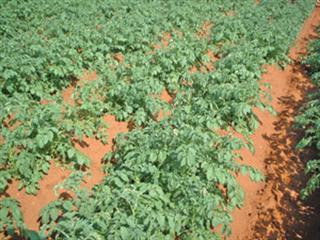
I’ve come across many farmers who don’t realise their potato crop is begging for water despite having had a downpour only a few days earlier. They’re amazed when I dig down into the ridge where all the roots are and find dry soil. Having ridges means that a relatively short downpour will see the rain flow down to the furrow between the ridges. In this way, most of the moisture ends up in the area where there are no roots. If you dig here you will find the soil saturated.
In other words, all too often the farmer won’t be looking in the right place to check the moisture content of the soil. Even after irrigation, the soil may appear moist until you dig into the root zone. You virtually have to over-irrigate to ensure there’s enough water in the correct zone. If you’re used to growing other crops and start with potatoes, the irrigation of this crop will likely involve a harsh learning curve.
Due to the quick start that the food reserves from the tuber provide, the crop’s requirements for water will increase very quickly as the leaf area increases at a rapid rate. The difference in moisture removed from the soil just two weeks later is phenomenal, and you need to take this into account.
Water content
Determining the water content of the soil means checking the soil in the right area (the root zone) and being able to gauge whether there’s sufficient moisture by the ‘feel’ of the soil. This will require a little experience. You will also have to take into account the fact that the moisture level in the area should be slightly higher during warm, windy conditions when the humidity is low. This often happens in the early part of the season, around September.
Stress symptoms
Learn to ‘read’ the message the plant is sending when it starts to show symptoms of stress, which include a duller, more blueish colour and slight loss of turgidity of the foliage. Look at the land edges where moisture shortages usually manifest first in order to learn how to recognise these symptoms. If you can see a noticeable difference in the appearance of the leaves in the irrigated area, you’ve started to irrigate too late.
A few weeks after emerging, the plant sends out underground stems. These produce swellings at the ends which become the crop or tubers. The amount produced may be limited by moisture stress at this time. This will result in all the energy that the plant produces going into fewer tubers, causing larger tubers to develop.
And this is not always a good thing. In my inexperience as a youngster, I grew a patch of potatoes for the staff of the estate where I worked. I allowed the potatoes to become dry in the beginning as I concentrated on more important crops. The result was one or two monster potatoes under each plant. The staff was so impressed. They thought I was a wonderful farmer! At that age I was too proud to confess that I had made a mistake and that the yield wasn’t good.
At all times
The best procedure is to provide adequate water at all times, which may involve daily light irrigations during stressful conditions. Not only will you get a very good yield, but also the right size tubers for the variety. Irrigation has a huge influence on yield. Over-irrigation can cause hollow centres, cracks and poor quality.
Potato scab
Another good reason to keep the moisture level constant is to reduce scab. Even in scab-infected soil, good irrigation practices will greatly reduce or eliminate scab scars on the tubers. By providing conditions for the highest yield you also provide the conditions for reducing the occurrence of the disease.
Contact Bill Kerr on 016 366 0616, or at [email protected]. Please state ‘Vegetable production’ in the subject line
of your email.












